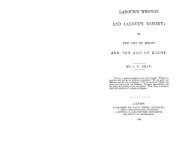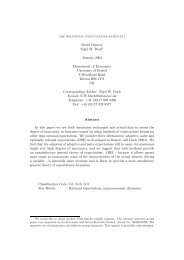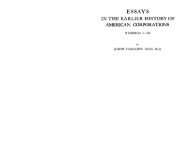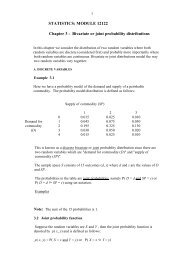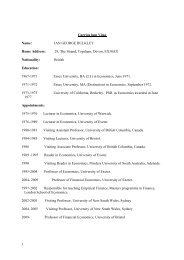'44 TEXTILES TEXTILESWood Streate, divers <strong>women</strong> kinde silver spinners."'These poor <strong>women</strong> worked in the spinning sheds<strong>of</strong> their masters, and thus the factory systemprevailed already in this branch <strong>of</strong> the textileindustry; the costliness <strong>of</strong> the fabrics produced forbadeany great expansion <strong>of</strong> the trade, and thereforethe Masters were not obliged to seek for labouroutside the pauper class.The Curate, Churchwardens, Overseers and Vestrymen<strong>of</strong> the parish <strong>of</strong> St. Giles, Cripplegate, drew upthe following statement : " There are in the saidParish, eighty five sheds for the spinning Gilt andSilver Thread, in which are 255 pair <strong>of</strong> wheels.The Masters with their Families amount unto 581These imploy poor Parish-Boys and Girls to thenumber <strong>of</strong>I275There are r 18 master Wire-Drawers, who withtheir wives, Children and Apprentices, make 826Master weavers <strong>of</strong> Gold and Silver Lace and Fringes 106Their Wives, Children, Apprentices and JourneyMen amount unto 2120Silver and Gold Bone-Lace makers, and Silver andGold Button makers with their Families 1000Windsters, Flatters <strong>of</strong> Gold and Silver and EngineSpinners with their Families 300Total 6208They continue : " The Poor's ,Rate <strong>of</strong> the Parishamounts to near Four Thousand Pounds perannum. . . . The Parish. . . . at thispresent are indebted One Thousand Six Hundred andFifty Pounds. Persons are daily removing out <strong>of</strong>the Parish, by Reason <strong>of</strong> this heavy Burthen, emptyHouses increasing. If a Duty be laid on the manufacture<strong>of</strong> Gold and Silver wyres the Poor mustnecessarily be in~reased."~l S.P.D., cccllx , Returns to Councll . . <strong>of</strong> houses, etc, 1637.' Care <strong>of</strong> tbc Parrsh <strong>of</strong> St. Gtlcs, Crzpplegate.Such a statement is in itself pro<strong>of</strong> that Gold andSilver Thread making ranked among the paupertrades in which the wages paid must needs be suplementedout <strong>of</strong> the poor rates.E. CONCLUSION.IT has been shown that in textile industries all spinningwas done exclusively by <strong>women</strong> and children, whilethey were also engaged to some extent in other processes,such as weaving, burling, bleaching, fulling,etc. The fact that the nation depended entirelyupon <strong>women</strong> for the thread from which its clothingand household linen was made must be rememberedin estimating their economic position. Even if noother work had fallen to their share, they can hardlyhave been regarded as mere dependants on theirhusbands when the clothing for the whole familywas spun by their hands ; but it has been explainedin the previous chapter that in many cases the mother,in addition to spinning, provided a large proportion<strong>of</strong> the food consumed by her family. If the fatherearned enough money to pay the rent and a fewother necessary expenses, the mother could and did,feed and clothe herself and her children by herown labours when she possessed enough capital toconfine herself wholly to domestic industry. Thevalue <strong>of</strong> a woman's productive capacity to her familywas, however, greatly reduced when, through poverty,she was obliged to work for wages, because then, farfrom being able to feed and clothe her family, herwages were barely adequate to feed herself.This fact indicates the weakness <strong>of</strong> <strong>women</strong>'s positionin the labour market, into which they were beingforced in increasing numbers by the capitalistic organisation<strong>of</strong> industry. In consequence <strong>of</strong> this weakness,a large proportion <strong>of</strong> the produce <strong>of</strong> a woman's labourWas diverted from her family to the pr<strong>of</strong>it <strong>of</strong> thecapitalist or the consumer ; except in the most skilled
TEXTILESbranches <strong>of</strong> the woollen industry, spinning was apauper trade, a " sweated industry," which did notprovide its workers with the means for keepingthemselves and their families in a state <strong>of</strong> efficiency,but left them to some extent dependent on othersources for their maintenance.Comparing the various branches <strong>of</strong> textile industrytogether, an interesting light is thrown uponthe reactions between capitalistic organisation <strong>of</strong>labour and wornep's economic position.Upper class <strong>women</strong> had lost their unique positionin the silk trade, and the wives <strong>of</strong> wealthy clothiersand wool merchants appear to have seldom takenan active interest in business matters. Thus it wasonly as wage-earners that <strong>women</strong> were extensivelyemployed in the textile trades.Their wages were lowest in the luxury tradesi.e., silk, silver and gold, and in the linen trade. Theformer were now wholly capitalistic, but the demandfor luxuries being limited and capable <strong>of</strong> littla expansion,the labour available in the pauper classeswas sufficient to satisfy it. The situation was differentin the linen and allied trades, where the demand forthread, either <strong>of</strong> flax or hemp, appears generally tohave been in excess <strong>of</strong> the supply. Although thelarger pqt <strong>of</strong> the linen manufactured in England wasstill produced under the conditions <strong>of</strong> domesticindustry, the demand for thread for trade purposeswas steady enough to suggest to Parish Authoritiesthe value <strong>of</strong> spinning as a means <strong>of</strong> reducingthe poor rates. It did not occur to them, however,that if the wages paid for spinning were higherthe poor would have been as eager to learn spinningas to gain apprenticeship in the skilled trades,and thus the problem <strong>of</strong> an adequate supply <strong>of</strong>yarn might have been solved at one stroke with theproblem <strong>of</strong> poverty itself ; no attempt was made toraise the wages, and the production <strong>of</strong> thread forTEXTILEStrade purposes continued to be subsidised out <strong>of</strong>the poor rates. The consequent pauperisation<strong>of</strong> large numbers <strong>of</strong> <strong>women</strong> was a greater disasterthan even the burthen <strong>of</strong> the poor rates. Instead<strong>of</strong> the independence and self-reliance which mighthave been secured through adequate wages, motherswere not only humiliated and degraded, but theirysical efficiency and that <strong>of</strong> their children wasowing to the inadequacy <strong>of</strong> the grudgingassistance given by the Churchwardens andOverseers.The woollen trade, in which capitalistic organisationhad attained its largest development, presentsa more favourable aspect as regards w~~men's wages.Already in the <strong>seventeenth</strong> <strong>century</strong> a spinster couldearn sufficient money to maintain her individual self.In spite <strong>of</strong> periodic seasons <strong>of</strong> depression, the woollentrade was rapidly expanding ; <strong>of</strong>ten the scope <strong>of</strong>the clothiers was limited by the quantity <strong>of</strong> yarnavailable, and so perforce they must seek for labouroutside the pauper class. Possibly a rise was alreadytaking place in the spinsters' wages at the close <strong>of</strong>the <strong>century</strong>, and it is interesting to note thatduring this period the highest wages were earned,not by the <strong>women</strong> whose need for them was greatest,that is to say the <strong>women</strong> who had children dependingexclusively on their wages, but rather by the well-todo<strong>women</strong> who could afford to buy the wool for theirspinning, and hold the yarn over till an advantageousopportunity arose for selling it.Spinning did not present itself to such <strong>women</strong>as a means <strong>of</strong> filling up vacant hours which they wouldotherwise have spent in idleness, but as an alternativeto some other pr<strong>of</strong>itable occupation, so numerousWere the opportunities <strong>of</strong>fered to <strong>women</strong> for productiveindustry within the precincts <strong>of</strong> the home.Therefore to induce <strong>women</strong> <strong>of</strong> independent positionto work for him, the Clothier was obliged to <strong>of</strong>fer
- Page 1 and 2:
WORKING LIFE OF WOMENIN THESEVENTEE
- Page 6 and 7:
4 INTRODUCTORYtragic class of wage
- Page 8 and 9:
8 INTRODUCTORY INTRODUCTORYDomestic
- Page 10 and 11:
INTRODUCTORYunmarried girls go out
- Page 12 and 13:
I 6 CAPITALISTS CAPITALISTS" I loos
- Page 14 and 15:
CAPITALISTSweak woman stands in the
- Page 16 and 17:
24 CAPITALISTS CAPITALISTS 25wife t
- Page 18 and 19:
2 8 CAPITALISTS CAPITALISTS 29Majes
- Page 20 and 21:
32 CAPITALISTSA warrant was issued"
- Page 22 and 23:
CAPITALISTSbusiness. " At O~tend, N
- Page 24 and 25:
CAPITALISTS CAPITALISTS41thro' her
- Page 26 and 27: AGRICULTUREwas made of their develo
- Page 28 and 29: AGRICULTUREis not drye as it should
- Page 30 and 31: 52 AGRICULTURE AGRICULTUREhave of h
- Page 32 and 33: 56 AGRICULTUREfor colonists in Virg
- Page 34 and 35: AGRICULTUREmaintain completely the
- Page 36 and 37: 64 AGRICULTUREtime was well spent i
- Page 38 and 39: AGRICULTUREExcept in exeptional cir
- Page 40 and 41: 72 AGRICULTURE AGRICULTURE 73mainta
- Page 42 and 43: 76 AGRICULTUREfor the impotent poor
- Page 44 and 45: AGRICULTUREwhich we can imagine tha
- Page 46 and 47: AGRICULTURE AGRICULTURE 85by his se
- Page 48 and 49: AGRICULTUREher work, but generosity
- Page 50 and 51: AGRICULTUREwife of Thos. Lyne. Toba
- Page 52 and 53: TEXTILESwas paid better than the la
- Page 54 and 55: TEXTILESroof provided them with the
- Page 56 and 57: 104 TEXTILESformulated by 25 Charle
- Page 58 and 59: 108 TEXTILES TEXTILES 109until the
- Page 60 and 61: TEXTILESon spinning for their livin
- Page 62 and 63: TEXTILESstill and dry within Doors,
- Page 64 and 65: 120 TEXTILES TEXTILESthe cloth made
- Page 66 and 67: 124TEXTILES TEXTILESin the closely
- Page 68 and 69: TEXTILESKingdom, it required a grea
- Page 70 and 71: 132 TEXTILES TEXTILESnot exceedl6 1
- Page 72 and 73: TEXTILES TEXTILES I37hours in four
- Page 74 and 75: ---P-I 4OTEXTILEScan be quoted of t
- Page 78 and 79: TEXTILEShigher wages than would hav
- Page 80 and 81: 1 52 CRAFTS AND TRADESdebts. For ex
- Page 82 and 83: I 56 CRAFTS AND TRADES CRAFTS AND T
- Page 84 and 85: 160 CRAFTS AND TRADES CRAFTS AND TR
- Page 86 and 87: 164 CRAFTS AND TRADESAmong thirty-n
- Page 88 and 89: CRAFTS AND TRADESalso met with as b
- Page 90 and 91: 172 CRAFTS AND TRADES CRAFTS AND TR
- Page 92 and 93: 176 CRAFTS AND TRADESto Henry Joyce
- Page 94 and 95: 180 CRAFTS AND TRADES CRAFTS AND TR
- Page 96: CRAFTS AND TRADESWardens and Brothe
- Page 99 and 100: P-I9OCRAFTS AND TRADESmarriage ; it
- Page 101 and 102: CRAFTS AND TRADEStaken our goods fr
- Page 103 and 104: 1g8CRAFTS AND TRADESresources turne
- Page 105 and 106: CRAFTS AND TRADESThere were fewer r
- Page 107 and 108: 206 CRAFTS AND TRADES CRAFTS AND TR
- Page 109 and 110: CRAFTS AND TRADESA large proportion
- Page 111 and 112: 214CRAFTS AND TRADES CRAFTS AND TRA
- Page 113 and 114: 218 CRAFTS AND TRADES CRAFTS AND TR
- Page 115 and 116: 222 CRAFTS AND TRADES CRAFTS AND TR
- Page 117: CRAFTS AND TRADES CRAFTS AND TRADES
- Page 120 and 121: CRAFTS AND TRADESfrom her fellow pa
- Page 122 and 123: PROFESSIONS 237PROFESSIONSIntroduct
- Page 124 and 125: 24O PROFESSIONS PROFESSIONStheir Th
- Page 126 and 127:
244 PROFESSIONS PROFESSIONS 245the
- Page 128 and 129:
PROFESSIONS PROFESSIONS 249profanat
- Page 130 and 131:
252PROFESSIONSGiles Moore enters in
- Page 132 and 133:
PROFESSIONScribed as one who " dist
- Page 134 and 135:
PROFESSIONS PROFESSIONS 261first ma
- Page 136 and 137:
264 PROFESSIONSGarrett's leg shall
- Page 138 and 139:
268 PROFESSIONSwhere there are none
- Page 140 and 141:
PROFESSIONS PROFESSIONS 273the numb
- Page 142 and 143:
PROFESSIONSexaminations, before six
- Page 144 and 145:
PROFESSIONS PROFESSIONS 281death me
- Page 146 and 147:
284 PROFESSIONS PROFESSIONSof confi
- Page 148 and 149:
288 PROFESSIONSextent they were whe
- Page 150 and 151:
CONCLUSIONor in her other facilitie
- Page 152 and 153:
CONCLUSION CONCLUSION 297in women's
- Page 154 and 155:
CONCLUSIONlaw of Nature, inviolable
- Page 156 and 157:
CONCLUSIONwere specially deprecated
- Page 158 and 159:
308 CONCLUSIONof the State, and the
- Page 160 and 161:
312 AUTHORITIES AUTHORITIES 313Cost
- Page 162 and 163:
AUTHORITIESMartindale, Adam, The Li
- Page 164 and 165:
County.Buckingham ..Cardigan .. ..C
- Page 166 and 167:
INDEXINDEXFlax, 64, 146, 246, 291 ;
- Page 168:
INDEXsmants, women( 50,65,157 ; mam



